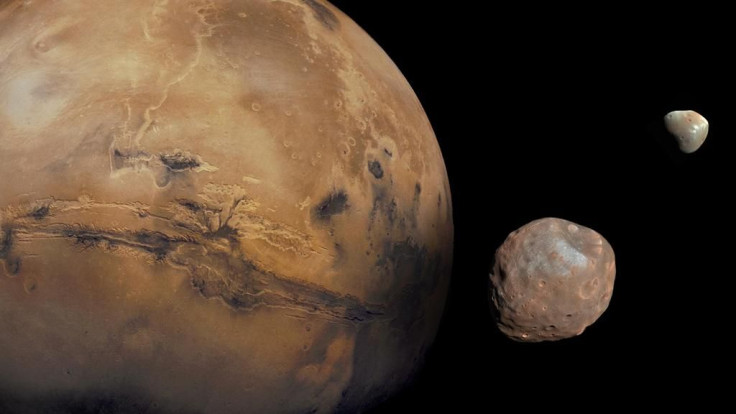Mars Moon Probe: Will These Two Nations Land On Phobos, The Doomed Moon?

Scientists are planning a trip to the moon — Phobos, the larger of the two moons that orbit Mars.
As most eyes are turned to Mars itself in the hope of finding traces of alien life there in the coming decades, France and Japan are working together on a project to launch a space probe to Phobos in 2024 and bring samples back to Earth, France-based international news service AFP reports. The two nations could come to a final decision on the idea later this year. But why Phobos? “Analysing its composition would solve a long-standing question as to its origins,” the news service said.
Some experts believe that Phobos, with its uneven shape, is an asteroid that got sucked up by Mars’ gravity and became chained to it in orbit, while others say the 17-mile-wide moon is a byproduct of the collisions and combinations that created Mars in the early days of the solar system.
France’s National Centre for Space Studies (CNES) would be working with the Japan Aerospace Exploration Agency on the probe project.
Read: Asteroids in Mars Orbit are the Bones of a Destroyed Planet
“It’s a very important mission because — besides the Moon — it would be the first time samples from the satellite of a planet would be brought back to Earth,” CNES President Jean-Yves Le Gall told AFP about the Martian Moons Exploration project. More good news is that landing on Phobos “should be twice as easy [as landing on Mars] because the probe will not have to go through the Martian atmosphere.”
And AFP notes that a space probe on Phobos could create a nice observation deck for viewing Mars. In addition to its close proximity to the planet, it revolves around Mars roughly every eight hours, streaking west to east across the Martian sky.
That’s if the spacecraft even makes it there; a Russian probe on its way to Phobos a few years ago never got out of Earth’s orbit and, after spending two months up there, fell into the Pacific Ocean.

Scientists only have a window of about 50 million years to study Phobos before it dies tragically. In that respect, it is perhaps suiting that the moon’s name is Greek for “fear.” NASA has previously reported that Phobos is getting about 6 feet closer to Mars every 100 years, and it will eventually meet oblivion by crashing into the Red Planet or breaking up into a ring.
To make matters worse, the space agency also says that the long grooves on the moon’s surface, once thought to be caused by a huge impact that formed a large crater, are actually “early signs of the structural failure that will ultimately destroy this moon.” Tidal forces coming from Mars are making these shallow grooves, which NASA compared to “stretch marks” — the same gravitational forces that are slowly pulling Phobos in.
Phobos made news earlier this year not for its scientific value but for making trouble: NASA recently had to think fast to stop their MAVEN space probe, which has been orbiting and viewing Mars for the last few years, from colliding with Phobos.
See also:
What It’s Like to Build Sand Castles on Titan, Saturn’s Moon
© Copyright IBTimes 2025. All rights reserved.



















